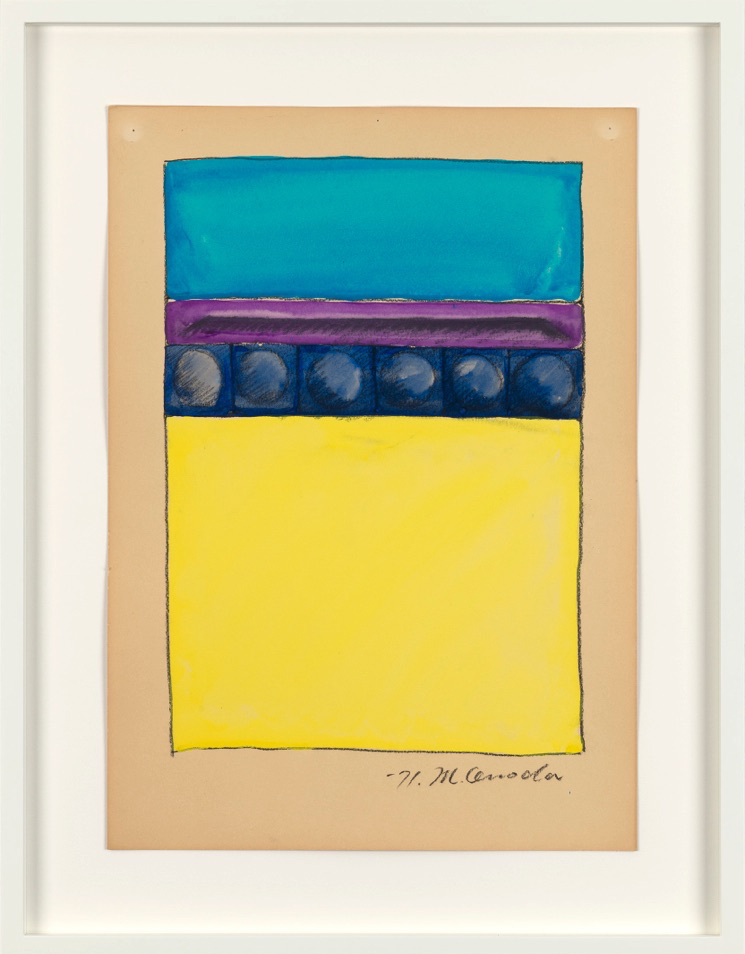37.5 × 27 cm
framed 48.8 × 37.7 × 2.8 cm
Onoda Minoru (1937, Manchuria – 2008, JP) studied design at the Osaka City Institute of Art, affiliated with the Osaka City Museum of Fine Arts. Around this time Onoda first encountered Gutai. Having been greatly influenced by van Gogh’s biography and letters and studying academic painting, “Gutai Art on the Stage,” held at Sankei Hall in Osaka in 1957 was an astounding experience for him, inspiring him to abandon figurative expression and embrace a new way of thinking.
In 1965, Onoda was invited to join Gutai Art Association by group member Sadamasa Motonaga. Onoda is often seen as part of Gutai’s third generation. During this period the group began moving away from the action painting of the early years and exploring approaches such as hard-edge painting – even Gutai leader Jirō Yoshihara delved into new areas in his work.
Art Informel was first introduced in Japan at the 1956 Exposition Internationale de l'Art Actuel. Onoda was critical of the fact that, the Japanese art world was dominated by artists who were totally devoted to the French trend. He attributed this to the Japanese temperament and a tendency toward certain aspects of prewar Fauvism. Onoda was hoping to discover something wondrous by making a huge meaningless accumulation of the countless identical symbols in his mind. He selected circles and lines to realize this goal. By endlessly painting circles and lines, he was able to create a proliferation of pictures with nearly limitless dimensions – which struck him as a new kind of meaninglessness. Onoda’s determination to withstand this meaningless quality became the foundation for his artistic activities. He painted dots of myriad sizes freehand and said that he was inspired by the Kobe industrial zone that had previously served as a motif for his figurative paintings from about 1958.
Gathering up pipes that had been discarded in the place where he was sketching, Onoda treated them as found objects, cutting the pipes into short pieces and using them to make protrusions in the canvas. Gradually, he began to depict the round shape of the pipes as circles. Then, Onoda made a bumpy support medium out of whitewash and adhesive, and painted an infinite number of dots on it. The circles proliferated from the center of the works, their varying sizes creating a sense of perspective. When viewed individually, the color of each circle is uneven and each has a minutely different size. Thus, Onoda’s paintings were the product of his deep understanding and careful calculation.
By the time Onoda joined Gutai, he had already achieved a consummate level of perfection in his work and was highly esteemed by Yoshihara. Though overwhelmed by the immense size of the other Gutai artists’ works, Onoda did not alter his basic approach, deciding instead to combine a number of works to create something with a larger appearance. After Gutai disbanded in 1972, Onoda opted for a conceptual style using acrylic paint, and the proliferating dots disappeared. In the 1980s, Onoda drilled holes in plywood, expressed his interest in gaps by staggering the cut pieces of wood, and eventually, added layers of bright colors to the edges of the pictures. Onoda explored this theme further in the 2000s by applying colored layers with a squeegee.
Onoda’s work was based on a systematic approach he called “My Circles.” Though these works are representative of the Gutai era, they were by no means influenced by the group itself. Onoda Minoru’s art just happened to dovetail with Gutai’s efforts to explore new directions in the late 1960s.
His paintings are in the collections of Museum Boijman van Beuningen, Rotterdam, NL; Sammlung Goetz, Munich, DE; Tate Modern, London, UK; numerous museums in Japan and private collections in Argentina, Belgium, Hong Kong, Japan, Switzerland, England, the United States. His paintings were included in the major Gutai retrospectives held in 2012 at the National Art Center, Tokyo, JP; Gutai : The Spirit of an Era and in 2013, Gutai : Splendid Playground, at the Solomon R. Guggenheim Museum, New York, US. He will be included the upcoming exhibition GUTAI | SAMMLUNG+GOETZ, Pinakothek der Moderne, Munich, DE, opening in June 2024.
Adaptation of 2017 text written by Koichi Kawasaki and translated by Christopher Stephens
